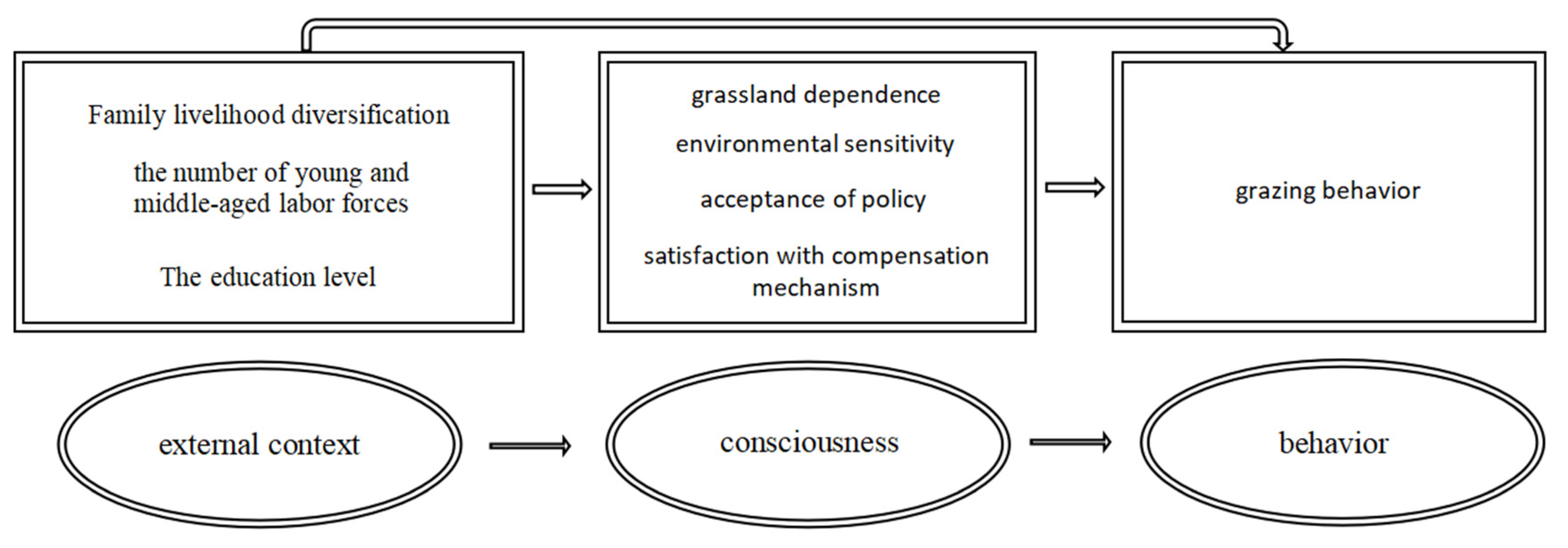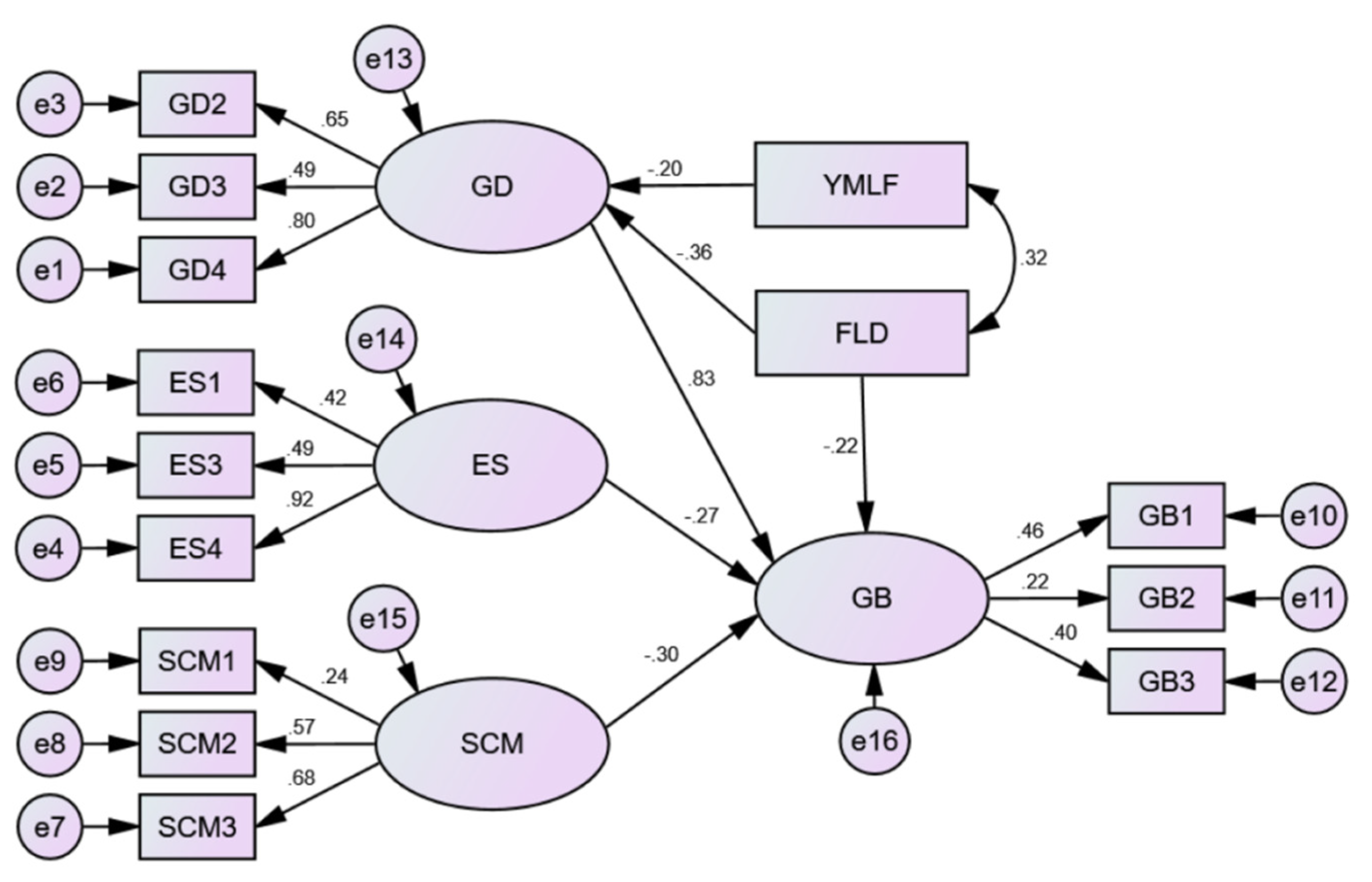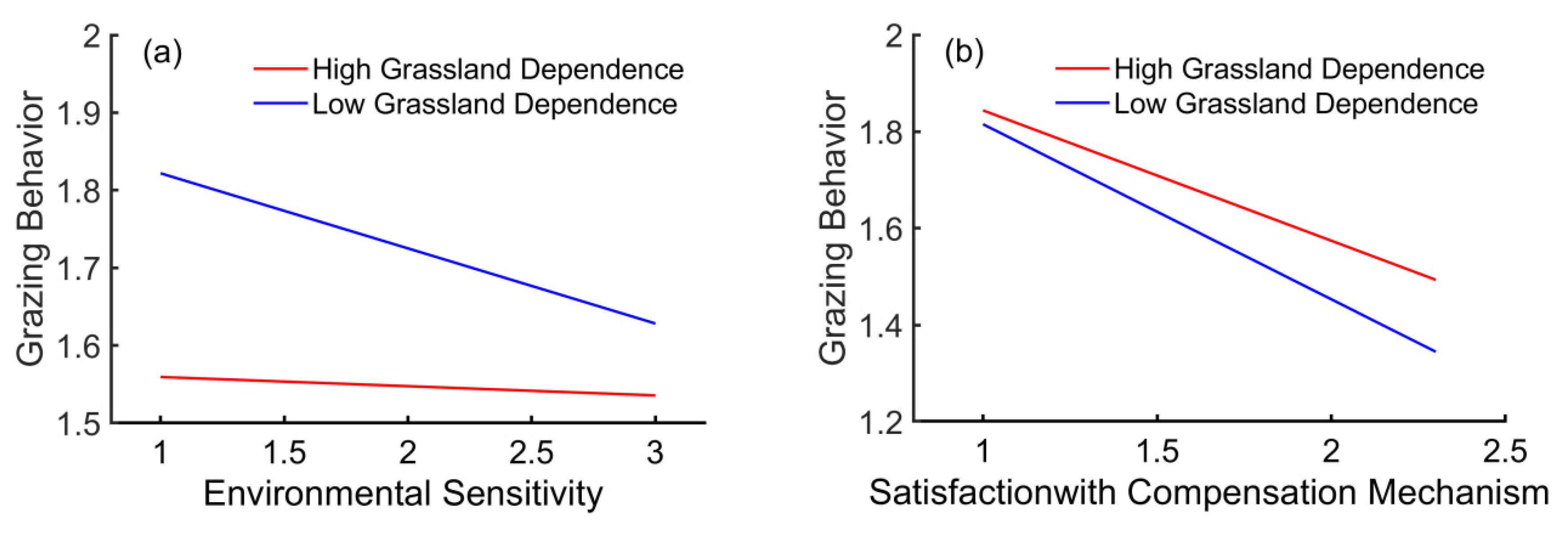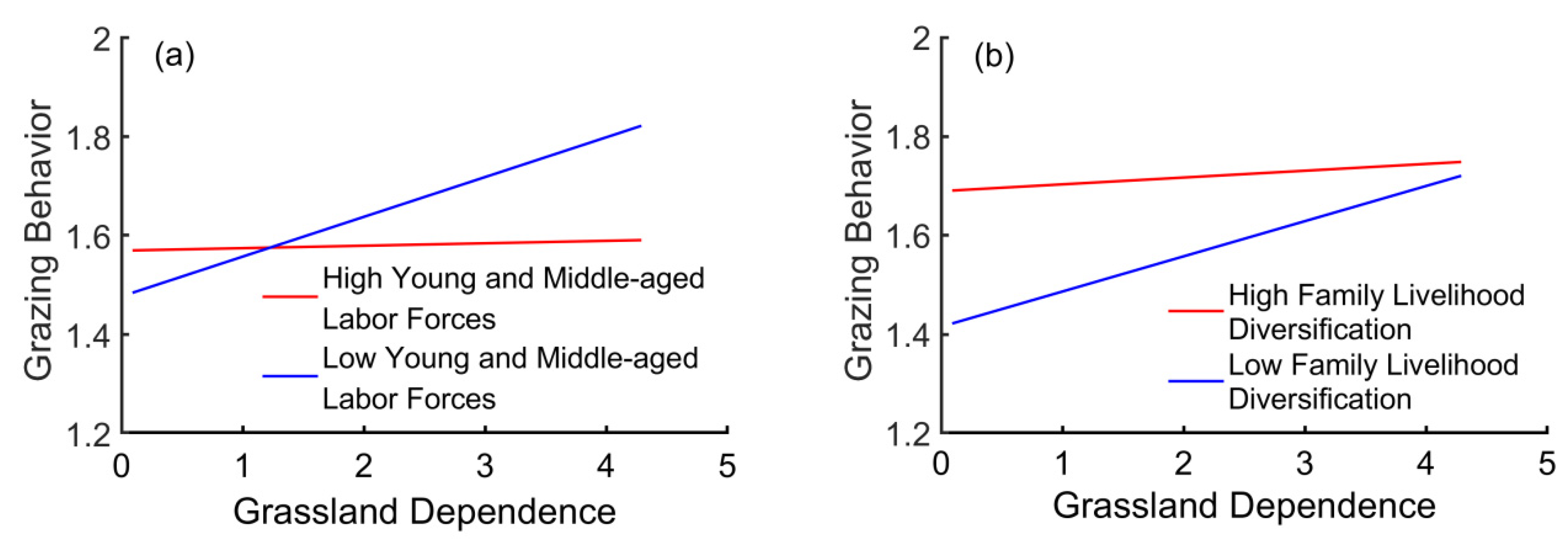Factors Influencing Grazing Behavior by Using the Consciousness-Context-Behavior Theory—A Case Study from Yanchi County, China
Abstract
:1. Introduction
2. Materials and Methods
3. Theoretical Review and Research Design
3.1. Theoretical Review
3.2. Research Design
3.2.1. The Direct Influence of Consciousness on Behavior
3.2.2. The Moderating Effect of the Family Characteristics of the Herders on the Consciousness–Behavior Relationship
4. Data Source and Reliability and Validity Test
4.1. The Data Source
4.2. Data Reliability and Validity Tests
5. Model Validation and Result Interpretation
5.1. Model Validation
5.2. The Main Effect of Consciousness on Behavior and the Interaction Effect between Consciousnesses
5.3. The Moderating Effect of Family Characteristics on the Relationship of “Consciousness → Behavior”
6. Discussion
6.1. The Grassland Dependence of Herders Has a Positive Impact and Interaction Effect on Their Grazing Behavior
6.2. The Sensitivity of Herders to the Ecological Environment Has an Inhibitory Effect on Their Grazing Behavior
6.3. The Satisfaction of Herders with the Grassland Ecological Compensation Mechanisms Is Helpful to Alleviate Their Grazing Behavior
6.4. Family Characteristics Has a Positive Effect on Reducing Grazing Behavior
7. Conclusions and Recommendations
Author Contributions
Funding
Acknowledgments
Conflicts of Interest
References
- Xue, Z.C.; Kappas, M.; Wyss, D. Spatio-temporal grassland development in inner Mongolia after implementation of the first comprehensive nation-wide grassland conservation program. Land 2021, 10, 38. [Google Scholar] [CrossRef]
- Marino, A.; Rodriguez, V.; Schroeder, N.M. Wild guanacos as scapegoat for continued overgrazing by livestock across southern Patagonia. J. Appl. Ecol. 2020, 57, 2393–2398. [Google Scholar] [CrossRef]
- Hou, C.X.; Zhou, L.H.; Wen, Y.; Chen, Y. Farmers’ adaptability to the policy of ecological protection in China—A case study in Yanchi County, China. Soc. Sci. J. 2018, 55, 404–412. [Google Scholar] [CrossRef]
- Cao, J.; Wei, C.; Adamowski, J.F.; Biswas, A.; Feng, Q. On China’s Qinghai-Tibetan Plateau, duration of grazing exclosure alters R:S ratio, root morphology and attending root biomass. Soil Tillage Res. 2021, 209, 104969. [Google Scholar] [CrossRef]
- Bremer, L.L.; Nathan, N.; Trauernicht, C.; Pascua, P.; Krueger, N.; Jokiel, J.; Barton, J.; Daily, G.C. Maintaining the many societal benefits of rangelands: The case of Hawaii. Land 2021, 10, 764. [Google Scholar] [CrossRef]
- Pfeiffer, M.; Langan, L.; Linstadter, A.; Martens, C.; Gaillard, C.; Ruppert, J.C.; Higgins, S.I.; Mudongo, E.I.; Scheiter, S. Grazing and aridity reduce perennial grass abundance in semi-arid rangelands—Insights from a trait-based dynamic vegetation model. Ecol. Model. 2019, 395, 11–22. [Google Scholar] [CrossRef]
- Prober, S.M.; Doerr, V.A.J.; Broadhurst, L.M.; Williams, K.J.; Dickson, F. Shifting the conservation paradigm: A synthesis of options for renovating nature under climate change. Ecol. Monogr. 2019, 89, e01333. [Google Scholar] [CrossRef]
- Kemp, D.; Han, G.D.; Hou, F.J.; Hou, X.Y.; Li, Z.G.; Sun, Y.; Wang, Z.W.; Wu, J.P.; Zhang, X.Q.; Zhang, Y.J.; et al. Sustainable management of Chinese grasslands—Issues and knowledge. Front. Agric. Sci. Eng. 2018, 5, 9–23. [Google Scholar] [CrossRef]
- Wang, Y.X.; Sun, Y.; Wang, Z.F.; Chang, S.H.; Hou, F.J. Grazing management options for restoration of alpine grasslands on the Qinghai-Tibet Plateau. Ecosphere 2018, 9, e02515. [Google Scholar] [CrossRef]
- Hou, L.L.; Xia, F.; Chen, Q.H.; Huang, J.K.; He, Y.; Nathan, R.; Scott, R. Grassland ecological compensation policy in China improves grassland quality and increases herders’ income. Nat. Commun. 2021, 12, 4683. [Google Scholar] [CrossRef]
- Hou, C.X.; Wen, Y.; He, Y.Q.; Liu, X.J.; Wang, M.M.; Zhang, Z.Y.; Fu, H.L. Public stereotypes of recycled water end uses with different human contact: Evidence from event-related potential (ERP). Resour. Conserv. Recycl. 2021, 168, 105464. [Google Scholar] [CrossRef]
- Merav, B.N.; Ira, S.; Marlen, M.; Sara, M. Factors affecting nursing students’ intention to report medication errors: An Application of the Theory of Planned Behavior. Nurse Educ. Today 2017, 58, 38–42. [Google Scholar] [CrossRef]
- Vannoppen, A.; Degerickx, J.; Gobin, A. Evaluating landscape attractiveness with geospatial data: A case study in Flanders, Belgium. Land 2021, 10, 703. [Google Scholar] [CrossRef]
- Wang, W.W.; Zhou, L.H.; Yang, G.J.; Sun, Y.; Chen, Y. Prohibited grazing policy satisfaction and life satisfaction in rural Northwest China—A case study in Yanchi County, Ningxia Hui autonomous region. Int. J. Environ. Res. Public Health 2019, 16, 4374. [Google Scholar] [CrossRef] [Green Version]
- Bencherif, S.; Burgas, D.; Manzano, P.; Mohamed, D. Current social and rangeland access trends among pastoralists in the Western Algerian steppe. Land 2021, 10, 674. [Google Scholar] [CrossRef]
- Assogba, N.P.; Zhang, D. An economic analysis of tropical forest resource conservation in a protected area. Sustainability 2020, 12, 5850. [Google Scholar] [CrossRef]
- Hu, Y.N.; Huang, J.K.; Hou, L.L. Impacts of the grassland ecological compensation policy on household livestock production in China: An empirical study in inner Mongolia. Ecol. Econ. 2019, 161, 248–256. [Google Scholar] [CrossRef]
- Liu, H.Y.; Hao, H.G.; Hu, X.J.; Du, L.S.; Zhang, Z.; Li, Y.Y. Livelihood diversification of farm households and its impact on cultivated land utilization in agro-pastoral ecologically-vulnerable areas in the Northern China. Chin. Geogr. Sci. 2020, 30, 279–293. [Google Scholar] [CrossRef]
- Faria, N. Predicting agronomical and ecological effects of shifting from sheep to cattle grazing in highly dynamic Mediterranean dry grasslands. Land Degrad. Dev. 2019, 30, 300–314. [Google Scholar] [CrossRef]
- Xu, J.; Xiao, Y.; Xie, G.D.; Wang, Y.Y.; Jiang, Y. Computing payments for wind erosion prevention service incorporating ecosystem services flow and regional disparity in Yanchi County. Sci. Total Environ. 2019, 674, 563–579. [Google Scholar] [CrossRef]
- Wei, X.; Zhou, L.H.; Yang, G.J.; Wang, Y.; Chen, Y. assessing the effects of desertification control projects from the farmers’ perspective: A case study of Yanchi County, Northern China. Int. J. Environ. Res. Public Health 2020, 17, 8145. [Google Scholar] [CrossRef] [PubMed] [Green Version]
- Lewin, J. Initiation of bed forms and meanders in coarse-grained sediment. GSA Bull. 1976, 87, 281–285. [Google Scholar] [CrossRef]
- Ajzen, I.; Madden, T.J. Prediction of goal-directed behavior: Attitudes, intentions, and perceived behavioral control. J. Exp. Soc. Psychol. 1986, 22, 453–474. [Google Scholar] [CrossRef]
- Guagnano, G.A.; Stern, P.C.; Dietz, T. Influences on attitude-behavior relationships: A natural experiment with curbside recycling. Environ. Behav. 1995, 27, 699–718. [Google Scholar] [CrossRef]
- Wang, J.M. The dimensional structure of environmental emotion and its impact on consumption carbon emission reduction behavior—The emotion-behavior two-factor theory hypothesis and its verification. Manag. World 2015, 12, 82–95. [Google Scholar]
- Hou, C.X.; Fu, H.L.; Liu, X.J.; Wen, Y. The Effect of recycled water information disclosure on public acceptance of recycled water—Evidence from residents of Xi’an, China. Sustain. Cities Soc. 2020, 61, 102351. [Google Scholar] [CrossRef] [PubMed]
- Wierzbinski, B.; Surmacz, T.; Kuzniar, W.; Witek, L. The role of the ecological awareness and the influence on food preferences in shaping pro-ecological behavior of young consumers. Agriculture 2021, 11, 345. [Google Scholar] [CrossRef]
- Li, X.Y.; Cirella, G.T.; Wen, Y.L.; Xie, Y. Farmers’ intentions to lease forestland: Evidence from rural China. Land 2020, 9, 78. [Google Scholar] [CrossRef] [Green Version]
- Shalizi, M.N.; Khurram, S.; Groninger, J.W.; Akamani, K.; Morrissey, R.C. Redbud woodlands conservation status in Afghanistan: Implications for sustaining vulnerable ecosystems under multiple drivers of change. Glob. Ecol. Conserv. 2020, 22, e00942. [Google Scholar] [CrossRef]
- Ning, J.; Jin, J.J.; Kuang, F.K.; Wan, X.Y.; Zhang, C.Y.; Guan, T. The valuation of grassland ecosystem services in inner Mongolia of China and its spatial differences. Sustainability 2019, 11, 7117. [Google Scholar] [CrossRef] [Green Version]
- Qiu, H.G.; Su, L.F.; Feng, X.L.; Tang, J.J. Role of monitoring in environmental regulation: An empirical analysis of grazing restrictions in pastoral China. Environ. Sci. Policy 2020, 114, 295–304. [Google Scholar] [CrossRef]
- Walelign, S.Z.; Nielsen, M.R.; Jacobsen, J.B. Roads and livelihood activity choices in the Greater Serengeti ecosystem, Tanzania. PLoS ONE 2019, 14, e0213089. [Google Scholar] [CrossRef]
- Kampen, J.K. Reflections on and test of the metrological properties of summated rating, Likert, and other scales based on sums of ordinal variables. Measurement 2019, 137, 428–434. [Google Scholar] [CrossRef]
- Hidrus, A.; Kueh, Y.C.; Norsa’adah, B.; Kuan, G. Malay version of exercise self-efficacy: A confirmatory analysis among malaysians with type 2 diabetes mellitus. Int. J. Environ. Res. Public Health 2020, 17, 922. [Google Scholar] [CrossRef] [PubMed] [Green Version]
- Lee, J.; Whittaker, T.A. The impact of item parceling on structural parameter invariance in multi-group structural equation modeling. Struct. Equ. Model. Multidiscip. J. 2021, 28, 684–698. [Google Scholar] [CrossRef]
- Kautish, P.; Paul, J.; Sharma, R. The moderating influence of environmental consciousness and recycling intentions on green purchase behavior. J. Clean. Prod. 2019, 228, 1425–1436. [Google Scholar] [CrossRef]
- Biro, M.; Molnar, Z.; Babai, D.; Denes, A.; Feher, A.; Barta, S.; Safian, L.; Szabados, K.; Kis, A.; Demeter, L.; et al. Reviewing historical traditional knowledge for innovative conservation management: A re-evaluation of wetland grazing. Sci. Total Environ. 2019, 666, 1114–1125. [Google Scholar] [CrossRef] [PubMed] [Green Version]
- Zhang, R.Y.; Wang, Z.W.; Han, G.D.; Schellenberg, M.P.; Wu, Q.; Gu, C. Grazing induced changes in plant diversity is a critical factor controlling grassland productivity in the Desert Steppe, Northern China. Agric. Ecosyst. Environ. 2018, 265, 73–83. [Google Scholar] [CrossRef]
- Strain, E.M.A.; Alexander, K.A.; Kienker, S.; Morris, R.; Jarvis, R.; Coleman, R.; Bollard, B.; Firth, L.B.; Knights, A.M.; Grabowski, J.H.; et al. Urban blue: A global analysis of the factors shaping people’s perceptions of the marine environment and ecological engineering in harbours. Sci. Total Environ. 2019, 658, 1293–1305. [Google Scholar] [CrossRef]
- Zhao, Y.Y.; Yan, Y.Z.; Liu, Q.F.; Li, F.Y. How willing are herders to participate in carbon sequestration and mitigation? An inner Mongolian grassland case. Sustainability 2018, 10, 2808. [Google Scholar] [CrossRef] [Green Version]
- Zhou, L.H.; Wang, Y.; Yang, G.J. Study on the Timely Adjustment of the grazing prohibition policy: Ban or lift? Empirical research from local government managers. Sustainability 2018, 10, 4852. [Google Scholar] [CrossRef] [Green Version]
- Johansson, V.; Kindvall, O.; Askling, J.; Franzen, M. Intense grazing of calcareous grasslands has negative consequences for the threatened marsh fritillary butterfly. Biol. Conserv. 2019, 239, 108280. [Google Scholar] [CrossRef]
- Strand, G.H.; Hansen, I.; de Boon, A.; Sandstrom, C. Carnivore management zones and their impact on sheep farming in Norway. Environ. Manag. 2019, 64, 537–552. [Google Scholar] [CrossRef] [Green Version]
- Guo, B.Y.; Xie, T.P.; Subrahmanyam, M.V. The impact of China’s grain for green program on rural economy and precipitation: A case study of yan river basin in the loess plateau. Sustainability 2019, 11, 5336. [Google Scholar] [CrossRef] [Green Version]
- Nguyen, T.V.; Lv, J.H.; Vu, T.T.H.; Zhang, B. Determinants of non-timber forest product planting, development, and trading: Case study in Central Vietnam. Forests 2020, 11, 116. [Google Scholar] [CrossRef] [Green Version]
- Shahzad, L.; Tahir, A.; Sharif, F.; Khan, W.U.D.; Farooq, M.A.; Abbas, A.; Saqib, Z.A. Vulnerability, well-being, and livelihood adaptation under changing environmental conditions: A case from mountainous region of Pakistan. Environ. Sci. Pollut. Res. 2019, 26, 26748–26764. [Google Scholar] [CrossRef]





| Level | Dimension | Index | Code | Mean Value | Standard Deviation | Composite Reliability (CR) | Average Variance Extracted (AVE) |
|---|---|---|---|---|---|---|---|
| Consciousness | Grassland Dependence (GD) | Does returning grazing land to grassland have a big impact on your family? | GD1 | 3.400 | 0.373 | 0.695 | 0.400 |
| How your flock is raised | GD2 | 3.218 | 0.365 | ||||
| Proportion of animal husbandry | GD3 | 3.234 | 0.120 | ||||
| How dependent your family is on the grassland | GD4 | 3.350 | 0.704 | ||||
| Environmental Sensitivity (ES) | Do you pay attention to changes in the ecological environment in production? | ES1 | 2.599 | 0.250 | 0.796 | 0.500 | |
| Do you think ecological protection is important? | ES2 | 1.972 | 0.207 | ||||
| What effect do you think the degradation of the ecological environment has on the total family income? | ES3 | 2.596 | 0.248 | ||||
| Do you feel that the local natural environment has changed since the grazing prohibition? | ES4 | 2.184 | 0.359 | ||||
| Acceptanceof policy (AP) | How did you first accept the grazing prohibition policy? | AP1 | 3.574 | 0.149 | 0.618 | 0.404 | |
| What is your current attitude toward the policy of grazing prohibition? | AP2 | 2.574 | 0.393 | ||||
| Are you willing to pay for the maintenance of the grassland in order to maintain the ecological environment? | AP3 | 3.383 | 0.036 | ||||
| Satisfaction with compensation Mechanism (SCM) | Are you satisfied with the implementation of the grazing prohibition policy? | SCM1 | 2.518 | 0.148 | 0.654 | 0.432 | |
| What do you think of the current ecological compensation standards? | SCM2 | 4.248 | 0.254 | ||||
| Do you think the current subsidy for returning grazing land to grassland can make up for your loss? | SCM3 | 4.511 | 0.176 | ||||
| Behavior | Grazing behavior (GB) | After the implementation of returning grazing land to grassland, how does your family’s farming scale change? | GB1 | 3.248 | 0.366 | 0.628 | 0.496 |
| After returning grazing land to grassland, the government will not provide subsidies. Can you still insist on a subsidy? | GB2 | 3.989 | 0.140 | ||||
| To improve the ecological environment, if the government grants certain subsidies, are you willing to give up grazing? | GB3 | 3.170 | 0.154 | ||||
| External context | Family characteristics | Educational level | EL | 3.690 | 0.062 | _ | _ |
| Family livelihood diversification | FLD | 3.388 | 0.044 | ||||
| Young and middle-aged labor forces | YMLF | 3.304 | 0.086 |
| Type of Index | Statistics for Goodness of Fit | Standard Value | Test Value | Adaptability of the Model |
|---|---|---|---|---|
| Absolute goodness of fit | CMIN/DF | <3.00 | 2.864 | Qualified |
| CMIN | <0.05 | p = 0.000 | Qualified | |
| RMSEA | <0.1 | 0.089 | Qualified | |
| Added-value goodness of fit | CFI | >0.90 | 0.931 | Qualified |
| NFI | >0.90 | 0.956 | Qualified | |
| IFI | >0.90 | 0.925 | Qualified | |
| RFI | >0.90 | 0.901 | Qualified | |
| Concise goodness of fit | PNFI | >0.5 | 0.540 | Qualified |
| PCFI | >0.5 | 0.524 | Qualified | |
| CN | >200 | 246.321 | Qualified |
| The Interaction and Moderating Effect | Coefficient of Significance |
|---|---|
| GD × ES → GB | −0.24 ** |
| GD × SCM → GB | −0.502 ** |
| ES × SCM → GB | 0.287 |
| YMLF → (GD → GB) | −0.308 *** |
| FLD → (GD → GB) | −0.37 * |
Publisher’s Note: MDPI stays neutral with regard to jurisdictional claims in published maps and institutional affiliations. |
© 2021 by the authors. Licensee MDPI, Basel, Switzerland. This article is an open access article distributed under the terms and conditions of the Creative Commons Attribution (CC BY) license (https://creativecommons.org/licenses/by/4.0/).
Share and Cite
Hou, C.; Zhang, M.; Wang, M.; Fu, H.; Zhang, M. Factors Influencing Grazing Behavior by Using the Consciousness-Context-Behavior Theory—A Case Study from Yanchi County, China. Land 2021, 10, 1157. https://doi.org/10.3390/land10111157
Hou C, Zhang M, Wang M, Fu H, Zhang M. Factors Influencing Grazing Behavior by Using the Consciousness-Context-Behavior Theory—A Case Study from Yanchi County, China. Land. 2021; 10(11):1157. https://doi.org/10.3390/land10111157
Chicago/Turabian StyleHou, Caixia, Mengmeng Zhang, Mengmeng Wang, Hanliang Fu, and Mengjie Zhang. 2021. "Factors Influencing Grazing Behavior by Using the Consciousness-Context-Behavior Theory—A Case Study from Yanchi County, China" Land 10, no. 11: 1157. https://doi.org/10.3390/land10111157
APA StyleHou, C., Zhang, M., Wang, M., Fu, H., & Zhang, M. (2021). Factors Influencing Grazing Behavior by Using the Consciousness-Context-Behavior Theory—A Case Study from Yanchi County, China. Land, 10(11), 1157. https://doi.org/10.3390/land10111157






